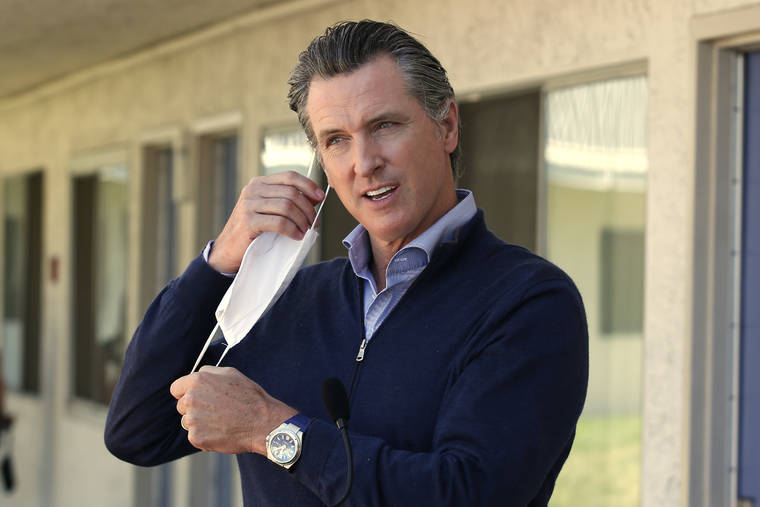SACRAMENTO, Calif. — With coronavirus cases surging, California Gov. Gavin Newsom said Tuesday that he plans to “tighten things up” when it comes to the state’s stay-at-home order ahead of a busy Fourth of July weekend.
California has confirmed close to 223,000 infections, a nearly 50% increase over two weeks ago that has been driven in part by the state’s ability to now test more than 100,000 people per day. But more concerning to officials is the steady growth in COVID-19 hospitalizations — a 43% increase in the past two weeks.
The state has been under a stay-at-home order since March 19, but Newsom has loosened restrictions in recent weeks to allow most businesses to open. Newsom said he would announce changes to the order Wednesday, hinting he would focus more on indoor restrictions where the virus is more likely to spread.
The state already requires everyone to wear a mask in most public places, both indoors and outdoors, when physical distancing isn’t possible.
“The framework for us is this: If you’re not going to stay home and you’re not going to wear masks in public, we have to enforce —and we will,” Newsom said, adding the state will be “a little bit more aggressive as it relates to guidelines on Fourth of July.”
Newsom’s cryptic warning, where he referred to the stay-at-home order as a “dimmer switch,” has businesses worried they could be forced to close again — especially the retail industry, which depends on in-person shopping.
“I’m hoping it won’t pertain to retail, at least this round,” said Rachel Michelin, president of the California Retailers Association. “Frankly, we were afraid of this, that if we saw an uptick of cases … we could see that dimmer switch coming in.”
Dr. Jeffrey Klausner, an epidemiology professor at the University of California, Los Angeles, and former deputy health officer for the city of San Francisco, said “it makes sense” that the state should renew restrictions because “people definitely got lax” in following public health orders, causing the virus to spread.
But he said state officials should focus on restrictions indoors because that’s where the disease is most likely to spread.
“It doesn’t make sense to close beaches, to close parks, to close outdoor recreation areas,” he said. “We don’t want to be pushing people indoors.”
Dr. George Rutherford, an epidemiologist at the University of California, San Francisco, said closing beaches is a “prudent move,” saying it keeps people from congregating. He said dialing back indoor dining would help. He added, however, that the biggest factor is for people to wear masks and maintain physical distancing.
“Just because it’s summer and they feel like having a barbecue with all their friends. It can’t be that way,” he said. “I don’t know how one legislates that.”
Jot Condie, who heads the California Restaurant Association, said he was concerned restaurant employees had been dragooned into a new, unfamiliar role: Health-code enforcers, in an environment where there are often no clear guidelines in place. And those vary from county to county.
Restaurants want to keep their employees safe, but many customers remain confused about face-mask requirements, he said. When must a customer replace a mask after taking a bite from a dinner? Or sipping a cocktail? Who makes that decision?
The state’s mask directive has helped but for restaurant workers, “These are all questions nobody has ever had to answer before,” Condi said.
Across the state, many local governments are already tightening restrictions. Counties surrounding the San Francisco Bay have delayed some reopenings as new cases increase. In Los Angeles, officials say they will close beaches and ban fireworks displays in the nation’s most populous county this weekend as it hit a one-day record of 2,903 new cases and more than 100,000 cases overall.
In the Central Valley, officials in Fresno ordered all bars to close as some hospitals invoked emergency protocols because they were nearing capacity.
“Our cases are not currently under control,” said Dr. Rais Vohra, interim health officer for Fresno County. “We’re quite worried that we don’t have room to expand.”
And in Riverside County, public health officials are seeing an increase in cases among younger people, many of them without symptoms of the virus even though they test positive.
“The majority of our cases are really groups of people who are coming together. They’re not social distancing. They’re not wearing face coverings,” Riverside County Public Health Director Kim Saruwatari said.
Last week, Newsom asked Imperial County to impose more restrictions after hospitals in the county near the U.S.-Mexico border had so many patients they had to transfer some to nearby facilities. On Monday, the county Board of Supervisors approved a plan that would close parks and force some businesses to shut down in-person shopping.
Altogether, California public health officials are closely monitoring 19 counties for outbreaks. Newsom said four more counties could be added to the list by Wednesday.
Newsom spoke at a motel in Pittsburg, where Contra Costa County is housing 164 homeless people during the pandemic with money from the state’s “Project HomeKey” program. Newsom said the program has secured 15,679 hotel rooms and served an estimated 14,200 people.
But Newsom’s remarks were interrupted by about a dozen people protesting racial injustice at the hands of police. The protesters blared a siren from a bullhorn while Newsom was speaking.
———
Associated Press writers Brian Melley, Christopher Weber and Michael R. Blood in Los Angeles and Amy Taxin in Orange County, California, contributed reporting.


